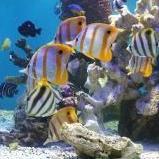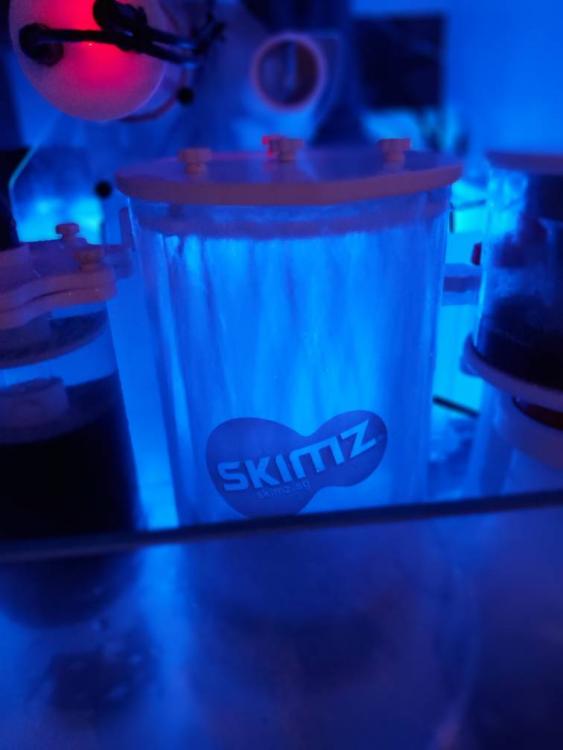Leaderboard
Popular Content
Showing content with the highest reputation on 05/20/2020 in all areas
-
From experience best is still use external temperature probe. Most accurate, save energy and money. Normally just buy a suitable probe and open the external casing, unplug the original temperature socket and plug in the after market external probe. Poof and you have yourself a efficient chiller1 point
-
Currently the Kalk stirrer is hooked to the Apex & switches ON for 2min. Once every hour. Quite a waste to use the Apex for this simple purpose. Tried using one of those standard smart wifi power plugs. But those only allow a max of about 16 events (i.e. 8x on + 8x off) This is not enough for the kalk stirrer. Objective of this mini project was to free up one plug on the Apex so it can be put into better close loop control of equipment (instead of just using as a standard timer) Using an FRM01 timer board. Set to Function 5 T1 = 2min, T2 = 60min The trigger button is added to manually trigger the stirrer to switch on. Case part is printed. Box is mounted to a 'dry' section of the cabinet.1 point
-
That is a great suggestion. Thanks! I was thinking of getting a Starry Blenny so hopefully Mr/Mrs White Tail will get along. Sent from Singapore Reef Club mobile app1 point
-
Agreed, definitely something different compared to the usual yelloweye kole tang from hawaii. i went with the indian ocean white-spotted variant for the same reason. Ultimately they’re all from the same genus though, and yes they’re very diligent at keeping the algae(especially film algae and diatoms) at bay, are slow growers and don’t grow very large so definitely a great tang for smaller setups. that said, ime while they don’t bother other tangs at all(i can understand most are concerned about tangs going at each other as a commonality in the hobby), they can for whatever reason get very aggressive towards algae blennies and stuff that resembles those in shape, like gobies. my hawaiian kole tang in my older system back then used to chase the salarias blenny till it disappeared whenever it saw it peep out of the rockwork. it didn’t kill it, but the blenny got considerably skinnier after i introduced the kole tang to my system and it had gotten very comfortable. in my current 6ft, my indian ocean yelloweye kole tang wore down a lagoon goby i had(by chasing it whenever it came out and essentially caused the goby to starve)and eventually murdered it. they seem to be generally very peaceful around tangs from other genus but from what i’ve seen their aggression is underrated when it comes to harassing other fish that it sees as a threat to its supply of algae(especially rock blennies and fish that resemble them in shape). also if i may, for fish stocking, apart from tangs for their utility, you could consider a pyramid butterfly(Hemitaurichthys polylepis) or 2. or 3.(they school, just like anthias, and aren’t heavy eaters like squirrel/soldierfishes. their diet is more akin to anthias). they are perhaps one of the few truly reef-safe butterflyfish out there and definitely not something you see in most reeftanks cause most will just assume all butterflies aren’t reef-safe. also a good conversation piece when others see it in your tank and immediately recognize that it’s a butterflyfish, but how are you keeping one in a tank full of corals!? 🧐 Sent from Singapore Reef Club mobile app1 point
-
Yes that is the little fella. The white tail I think is a good option, something a little different but also a hard worker. I hear they are normally compliant so will just hope he(she?) is going to be a model citizen. Plan is to catch my Yellow Tang and reintroduce them together to reduce any aggression and then let them sort it out a fresh. Whilst talking about fish, does anyone have any suggestions for stocking? I have a stocking list already but am always looking for something a little different. Let me know your thoughts, but whatever it is it has to be a good looker! Haha. Sent from Singapore Reef Club mobile app1 point
-
I opted to run my system’s water temperature in the mid 27 (degree celsius) ranges, with the max hitting 28.0 degrees. Two reasons for this: 1. Main reason being to ameliorate large temperature swings in the event of an extended power outage or chiller failure and I need some time to get everything running again. 2. I’m running a system with a fairly large water volume for a home aquarium of approx. 1,200 litres on a 1hp chiller. I had to compensate for the reduced efficiency that wouldn’t be able to hold up punching above its weight in terms of chilling the water to temperatures more than 2 degrees lower than the ambient temperature, particularly given our typically hot climate. I’ve also gotten used to reading the temperature a la fahrenheit, as I find it more attuned when monitoring a smaller temperature range. While I plan to upgrade to a better unit in the future, I have no qualms with the chiller I’m using now in tandem with an external thermostat. This external temperature controller with its own probe allows me to adjust more precisely at what temperature I want my chiller to kick on and off. The main benefit of this is I can more closely tweak the temperature range of my system for better stability, for e.g. having less than half a degree celsius’ worth of difference in between the chiller cooling the tank and shut-off periods. Currently, I’ve calibrated it to switch the chiller on when the probe reads 27.5 degrees celsius on its display panel. I set it to kick on with a temperature difference of only 0.3 degrees celsius, and going by these settings, the chiller kicks in on average every 50mins~1h20mins depending on the ambient temperature/time of day(also influenced by my light schedule ramping up and down, max intensity etc). It usually takes between 20-25mins to cool 0.3 degrees, which is acceptable to me considering the large overall water volume in my system. The controller also allows me the customisability of a delay time between switching the chiller on and it kicking in, which I’ve set for 60seconds. Sent from Singapore Reef Club mobile app1 point
-
Hi, It’s really a very detailed write out of your tank process. I do have slot of questions on mind 1) is your sump on a roller board where you can pull out your sump for effective maintenance? 2) why do you need 3 source to bring your nutrients down? ATS, Refrigum and the zeovit stones. Are you intending to keep a lot of fishes? 3) Can you explain what are you intending to dose? It seems like there’s 3 dosing pumps on top of your KH guardian. 4) how you do fair between KH guardian and alkatronic? 5) it seems like you’re using calcium reactor and also dosing KH and cal. Why not just get a bigger calcium reactor to do the job. 6) very very nice write up on the QT fish system. Will 10g a bit too small for the fishes? Especially tangs? What will your schedule or plan in introducing fishes? 2-3fishes every month? And I find it’s abit too harsh on the new fishes to go thru so many treatment before putting in your tank. It will stress the fishes more. IMO. Doing the TTM & freshwater dip is good but after that I’ll just observe and see is there anymore parasites then do the necessary treatment. Lastly I can’t wait to see your build. [emoji1303] Probably can head over and chat with you more after CB to learn more from you. [emoji4] Sent from my iPhone using Tapatalk1 point
-
Wow! Wow! Wow!!!! Finally after a long wait from you initial pics shared. Thanks for sharing so generously. Will definitely follow your thread. Now can slowly take my time to read up.1 point
-
1 point
-
A new toy. The Skimz ZAR-127 automatic zeolite reactor takes all (well some) of the effort out of the zeovit system. I am always looking for low maintenance, which i take to mean that I dont have to intervene too much. I must say it is doing really well! (fingers crossed I haven't hexed it saying that). It has an adjustable flow rates for differing amounts of the zeolite media and to suit different tank sizes. What isn't really advertised is that you can double the flow rate at the touch of a button. As such it can run from 60L/H to 480L/H, which will happily serve tanks from 120L in size to roughly 900L. It's great to have a little upgradability built-in and keep the footprint down. Well done Skimz! Sent from Singapore Reef Club mobile app1 point
-
What a great idea! I may use this to make a quick connect fitting for my Roller Mat. I really think that 3D Printing is the perfect accompaniment for reefing hobby. Thanks for sharing. Sent from Singapore Reef Club mobile app1 point




.thumb.jpg.139c50303c12ea1c8328e389a9b5447d.jpg)
.thumb.jpg.3fdacf225c3b3478d5a43a10b9a2c078.jpg)

